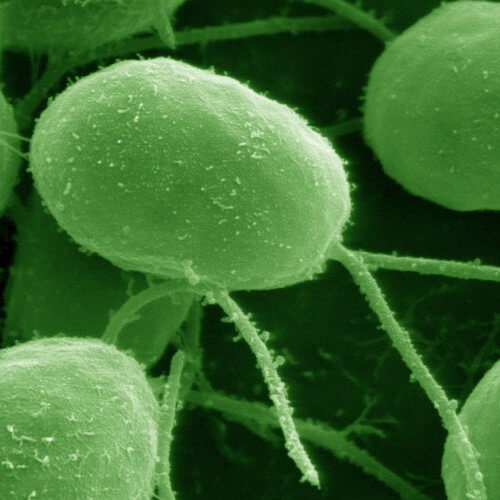"Chlamy", the single-celled green algae Chlamydomonas reinhardtii is very popular among geneticists and neurophysiologists. These plant creatures are equipped with a pair of tentacles and move en masse into the sunlight to carry out the process of photosynthesis for their sustenance

By: Shimon Bogan
"Chlamy", the single-celled green algae Chlamydomonas reinhardtii is very popular among geneticists and neurophysiologists. These plant creatures are equipped with a pair of tentacles and move en masse to the sunlight to carry out the process of photosynthesis for their sustenance.
The algae's sensory organ, the "eye", is nothing more than a cluster of channelrhodopsin-2 proteins on the cell wall. The protein "senses" light and transmits the information as an electrical signal for further processing and response. The spatial structure of the protein is arranged to form channels. These channels open under the influence of light rays of defined wavelengths, similar to the pupil or aperture of a camera, and allow the passage of simple ions through the cell membrane, from the aqueous environment into the cell fluid. These ions drive a chain of signals and reactions, just like the biophysical process that occurs in nerve cells in animals.
It was found that proteins with the same function, but with high complexity and complexity, are the missing link in the vision process in animals, including humans, who suffer from visual degeneration due to the depletion and disappearance of cones and rods in the retina, in the degenerative diseases retinitis pigmentosa or age-related Macular Degeneration (AMD)
. The good news is that the continuation of the neural chain is not damaged and is able to communicate well with the visual center in the brain.
The channelrhodopsin-2 (ChR2) is a single protein encoded by a single gene. It is therefore an ideal candidate for gene therapy of the mentioned diseases. In 2006, the group of Dr. Zhou Hua Pan injected a transgenic virus and transplanted the gene into damaged retinas of mice whose vision had deteriorated. The visual functions returned to normal less than three months later, on the first try! (link)
Starting from December 2015, an experimental treatment of the gene therapy from a plant source, with the approval of the FDA, is being carried out in the first 15 sick people.
מקור
This news was inspired by a sequence of related events, which are worth noting in the blog:
FDA approval was granted to start experimental treatments in humans suffering from degenerative blindness, by injecting an "orphan" genetic drug into the retina of the eye. Approval was granted to RetroSense Therapeutics LLC, Michigan, for immediate application of the 001-RST preparation, beginning in late August 2015.
Biomimetic development, presentation, licensing and operation of an implanted "bionic" eye
The book Optogenetics: Light-Sensing Proteins and Their Applications edited by H. Yawo, H. Kandori, A. Koizumi Springer Publishing, June 2015.
The book Biomimetic Technologies: Principles and Applications edited by TD Ngo, Woodhead Publishing, July 2015 was published.
, H. Yawo, H. Kandori, A. Koizumi Springer Publishing, June 2015.

One response
Peace,
I wanted to ask if there are any other articles on the subject?
Also, is there an article describing experiments on the subject and its expansion?
Thank you
Micah Lehman